 |

Go to:
Movies
-Large-scale structure
-Clusters of galaxies
-Flying through clusters
-Flying through filaments
-4D Universe
-Flying through universe
-Individual galaxies
-Movie formats
Images
-Clusters
-3D-View of cosmic structure
|
 |
Visualization of Computer Simulations:
On this page, you may download movies and images that we
produced from our numerical simulations. You are welcome to use this material
for illustrative purposes in talks or posters.
Note however that the selection below is not
complete. Additional visualization material can be found on
the pages that describe indididual projects in more detail, e.g.:
 The Millennium Simulation Project The Millennium Simulation Project
 The Hubble Volume Project The Hubble Volume Project
 Intermediate-Scale Simulations Intermediate-Scale Simulations
 Higher Resolution Simulations in smaller boxes Higher Resolution Simulations in smaller boxes
We have loosely grouped the available movies and images into different
categories. Note however that both the simulation and visualization techniques
employed in each case may vary widely within each category.
Also note that the images contained on this page are only a small selection
from our pool of simulation pictures. Further material with more detailed
explanations of the scientific background of each simulation can be found
on the pages of individual projects.
Copyright statement:
When material of this page is used, credit has to be given to the author(s)
as well as to the Max-Planck-Institute for Astrophysics.
Movies of large-scale structure in the Universe
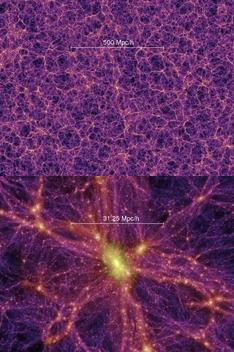
This movie shows the dark matter distribution in the universe
at the present time, based on the Millennium
Simulation, the largest N-body simulation carried out thus
far (more than 1010 particles). By zooming in on a
massive cluster of galaxies, the movie highlights the morphology of the structure on different
scales, and the large dynamic range of the simulation
(105 per dimension in 3D). The zoom extends from
scales of several Gpc down to resolved substructures as small
as ~10 kpc.
 High Quality [divx5, 48.6 MB, 1024x768] High Quality [divx5, 48.6 MB, 1024x768]
 Medium Quality [divx5, 13.4 MB, 640x480] Medium Quality [divx5, 13.4 MB, 640x480]
 Low Quality [divx5, 10.8 MB, 512x384] Low Quality [divx5, 10.8 MB, 512x384]
 Slow Zoom [divx5, 165.6 MB, 1024x768] Slow Zoom [divx5, 165.6 MB, 1024x768]
Credit: Springel et al. (Virgo Consortium)
Simulation code: Gadget-2
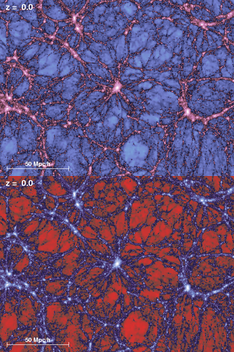
This animation shows the formation of large-scale sturcture in the dark
matter distribution, from redshift z=20 to the present time. The movie
is centered on a forming rich cluster of galaxies.
 Color
scheme 1 [divx5, 11.1 MB, 1024x768] Color
scheme 1 [divx5, 11.1 MB, 1024x768]
 Color
scheme 1 [divx5, 7.4 MB, 640x480] Color
scheme 1 [divx5, 7.4 MB, 640x480]
 Color
scheme 2 [divx5, 11.1 MB, 1024x768] Color
scheme 2 [divx5, 11.1 MB, 1024x768]
 Color
scheme 2 [divx5, 7.4 MB, 640x480] Color
scheme 2 [divx5, 7.4 MB, 640x480]
Credit: Volker Springel
Simulation code: Hydra
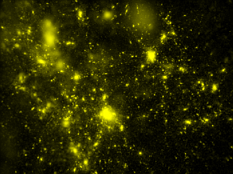
Enjoy a virtual fly-through! This movie travels though the dark matter
distribution in one of our GIF simulation boxes.
 GIF
fly-through [mpeg-2, 12.2 MB, 768x576] GIF
fly-through [mpeg-2, 12.2 MB, 768x576]
 GIF
fly-through [divx5, 16.2 MB, 640x480] GIF
fly-through [divx5, 16.2 MB, 640x480]
Credit: Joerg Colberg (Encoding: Springel)

This visualization shows our "Local Universe", as simulated in the constrained
realization project. The Local Group is in the centre of the sphere. In
the initial orientation of the sphere, the Great Attractor is on the left,
and the Cetus Wall on the lower right.
 Contrained
realization [divx5, 20.5 MB, 400x400] Contrained
realization [divx5, 20.5 MB, 400x400]
 Contrained
realization [mpeg-2, 10.3 MB, 576x576] Contrained
realization [mpeg-2, 10.3 MB, 576x576]
Credit: Volker Springel
Simulation code: Gadget
Movies of clusters of galaxies
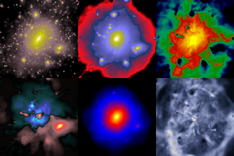 This
high-resolution animation shows the formation of a rich cluster of galaxies
from cosmological initial conditions. The simulation follows dark matter
and baryonic gas. This
high-resolution animation shows the formation of a rich cluster of galaxies
from cosmological initial conditions. The simulation follows dark matter
and baryonic gas.
 Cluster
Movie [divx5, 112 MB, 960x640] Cluster
Movie [divx5, 112 MB, 960x640]
 Just
dark matter [divx5, 34 MB, 768x768] Just
dark matter [divx5, 34 MB, 768x768]
Credit: Volker Springel
Simulation code: Gadget-2
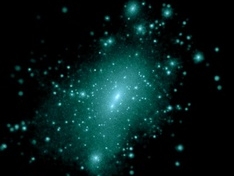 The
dark matter substructure in a cluster at redshift z=0. The
dark matter substructure in a cluster at redshift z=0.
 Rotating
cluster [divx5, 10.8 MB, 576x576] Rotating
cluster [divx5, 10.8 MB, 576x576]
 Rotating
cluster [mpeg-2, 17.1 MB, 576x576] Rotating
cluster [mpeg-2, 17.1 MB, 576x576]
Credit: Volker Springel
Simulation code: Gadget
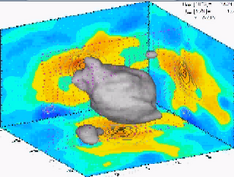 Formation
of a magnetized galaxy cluster. Formation
of a magnetized galaxy cluster.
 Magnetized
cluster [quicktime, 8.1 MB, 320x240] Magnetized
cluster [quicktime, 8.1 MB, 320x240]
Credit: Klaus Dolag
Simulation code: Grape-MSPH
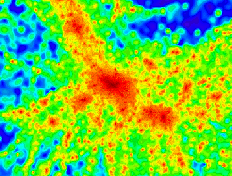 Formation
of a galaxy cluster in the tCDM GIF simulation. (starting redshift z=20) Formation
of a galaxy cluster in the tCDM GIF simulation. (starting redshift z=20)
 Cluster
movie [mpeg-1, 900 kB, 272x272] Cluster
movie [mpeg-1, 900 kB, 272x272]
 Cluster
movie [mpeg-2, 4.2 MB, 576x576] Cluster
movie [mpeg-2, 4.2 MB, 576x576]
Credit: Joerg Colberg
Simulation code: Hydra
Flying through a galaxy cluster
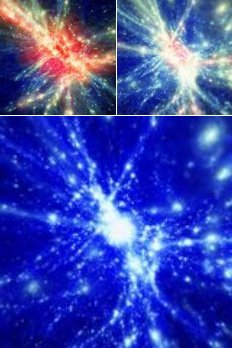 Flying through the hot plasma atmosphere of a galaxy clusters, reveling
the richness of substructure and their dynamics during the formation of
the largest gravitational bound objects in the universe. When falling
into the cluster, the galaxies are losing their gaseous atmosphere
(appearing in white), forming comet-like features of gas trails.
Due to tidal forces these trails sometimes get deformed into arc-like structures.
Flying through the hot plasma atmosphere of a galaxy clusters, reveling
the richness of substructure and their dynamics during the formation of
the largest gravitational bound objects in the universe. When falling
into the cluster, the galaxies are losing their gaseous atmosphere
(appearing in white), forming comet-like features of gas trails.
Due to tidal forces these trails sometimes get deformed into arc-like structures.
Flight through cluster visualizing temperature:
 Final state [mpeg-4, 26.7 MB, 800x800]
Final state [mpeg-4, 26.7 MB, 800x800]
 Evolving [mpeg-4, 26.1 MB, 800x800]
Evolving [mpeg-4, 26.1 MB, 800x800]
Flight through cluster visualizing density:
 Evolving [mpeg-4, 23.9 MB, 800x800]
Evolving [mpeg-4, 23.9 MB, 800x800]
Credit: Klaus Dolag
Simulation code: Gadget-2
Vizualisation code: Splotch
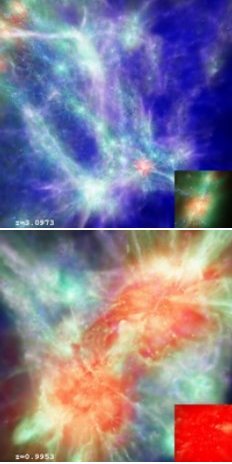 The evolution of a galaxy cluster from very early times on.
The vizualisation starts when the universe has just 5% of its actual
age, and the first galaxies are forming (about z=6). The light would need about 30 millions of years to
pass the region of space shown. Shown is the temperature of the
plasma, which fills the space between stars and galaxies.
At z about 3.5 the universe has 15% of its actual age and the forming
large-scale structure (filaments) can be clearly recognized. The inlay
down in the right shows a zoom into the interior of one of the two
prominent protoclusters. In such structures (clusters of galaxies)
several thousands of galaxies can be bound by gravity.
At z about 0.8 the universe is half as old as now and the two
prominent protoclusters begin to merge into one galaxy cluster. Such
events are the most energetic phenomena since universe was born in the
Big Bang. In the final phase of this merging event a gigantic
shockwave is initiated, releasing enormous amount of energy.
The evolution of a galaxy cluster from very early times on.
The vizualisation starts when the universe has just 5% of its actual
age, and the first galaxies are forming (about z=6). The light would need about 30 millions of years to
pass the region of space shown. Shown is the temperature of the
plasma, which fills the space between stars and galaxies.
At z about 3.5 the universe has 15% of its actual age and the forming
large-scale structure (filaments) can be clearly recognized. The inlay
down in the right shows a zoom into the interior of one of the two
prominent protoclusters. In such structures (clusters of galaxies)
several thousands of galaxies can be bound by gravity.
At z about 0.8 the universe is half as old as now and the two
prominent protoclusters begin to merge into one galaxy cluster. Such
events are the most energetic phenomena since universe was born in the
Big Bang. In the final phase of this merging event a gigantic
shockwave is initiated, releasing enormous amount of energy.
The second movie shows a more quietly forming galaxy cluster.
 Merging cluster [mpeg-4, 35.9 MB, 800x800]
Merging cluster [mpeg-4, 35.9 MB, 800x800]
 Quiet cluster [mpeg-4, 35.4 MB, 800x800]
Quiet cluster [mpeg-4, 35.4 MB, 800x800]
Credit: Klaus Dolag
Simulation code: Gadget-2
Vizualisation code: Splotch
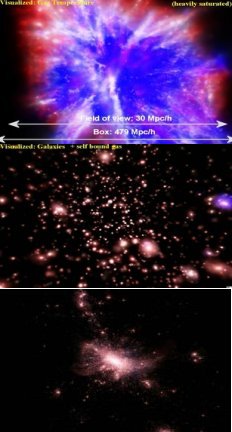 Flight through a high resolution simulation of a galaxy cluster.
After zooming into the cluster, the flight follows an orbit around the
center. Visible are prominent structure within the hot plasma, building the
atmosphere of the cluster. Some of the structures inside the cluster
are able to maintain an self-bound atmosphere for a while (shown in light
blue). The population of free floating stars, which originate
from destroyed galaxies show prominent stripes as imprint of the
orbits of the former galaxies they belong to. Despite such
destruction, more than thousand of individual
galaxies can still be identified within the cluster, even forming new
stars in their centers (shown in dark blue). Only a small number of them are still
maintaining an own, hot, self-bound atmosphere (shown in light blue). For the zoom
out all stars formed within the simulation are shown.
Flight through a high resolution simulation of a galaxy cluster.
After zooming into the cluster, the flight follows an orbit around the
center. Visible are prominent structure within the hot plasma, building the
atmosphere of the cluster. Some of the structures inside the cluster
are able to maintain an self-bound atmosphere for a while (shown in light
blue). The population of free floating stars, which originate
from destroyed galaxies show prominent stripes as imprint of the
orbits of the former galaxies they belong to. Despite such
destruction, more than thousand of individual
galaxies can still be identified within the cluster, even forming new
stars in their centers (shown in dark blue). Only a small number of them are still
maintaining an own, hot, self-bound atmosphere (shown in light blue). For the zoom
out all stars formed within the simulation are shown.
 English version [mpeg-4, 79.4 MB, 1024x768]
English version [mpeg-4, 79.4 MB, 1024x768]
 German version [mpeg-4, 79.4 MB, 1024x768]
German version [mpeg-4, 79.4 MB, 1024x768]
Credit: Klaus Dolag
Simulation code: Gadget-2
Vizualisation code: Splotch
 |
Flying through a filament
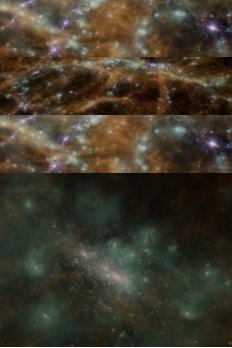 Flight through a evolving cosmic structure (filament) which
connects several galaxy clusters. The gas between the galaxy
clusters is visualized in colors ranging from brown to light blue,
the stars formed within the simulation are colored from purple to white.
The first movie shows a large field of view and evolves only slow in
time. The second movie capture a fast fly through
the final structure with a more narrow field of view.
Flight through a evolving cosmic structure (filament) which
connects several galaxy clusters. The gas between the galaxy
clusters is visualized in colors ranging from brown to light blue,
the stars formed within the simulation are colored from purple to white.
The first movie shows a large field of view and evolves only slow in
time. The second movie capture a fast fly through
the final structure with a more narrow field of view.
 Filament (larg field of view) [mpeg-4, 7.8 MB, 1032x310]
Filament (larg field of view) [mpeg-4, 7.8 MB, 1032x310]
 Filament (fast fly throght) [mpeg-4, 5.6 MB, 700x524]
Filament (fast fly throght) [mpeg-4, 5.6 MB, 700x524]
Credit: Klaus Dolag
Simulation code: Gadget-2
Vizualisation code: Splotch
The 4D Universe
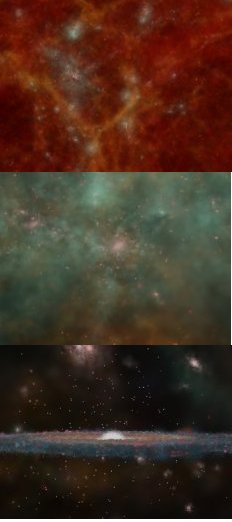 Flying through a evolving cosmic structure, starting at early times (the
so called dark ages), where the material in the universe is in a cold and
neutral state. First objects collapse and form the first proto galaxies
embedded in a heated atmosphere, hosting the first stars and QSOs. The
energetic light from those stars/QSOs heat and ionize the material in the
universes (note that this simulation takes this not self consistently into
account, but uses a uniform, time dependent background radiation
field), revealing the fine, filamentary structures formed so
far. Now, lager and larger structures form within a long and violent
process of merging of smaller structures leading to the largest
objects observed in the present universe, the so called galaxy
clusters, still connected to each other by filamentary structures.
At the end, the movie zooms down to a spiral galaxy, similar
to what we expect the Milky Way looks like, for a final fly-by. In this
case the galaxy is artificial constructed from an astronomical image,
as it is still impossible to obtain such detailed and realistic galaxies
directly within cosmological simulations. This movie is also shown in the
Virtual Reality facility of the new Turin Planetarium.
Flying through a evolving cosmic structure, starting at early times (the
so called dark ages), where the material in the universe is in a cold and
neutral state. First objects collapse and form the first proto galaxies
embedded in a heated atmosphere, hosting the first stars and QSOs. The
energetic light from those stars/QSOs heat and ionize the material in the
universes (note that this simulation takes this not self consistently into
account, but uses a uniform, time dependent background radiation
field), revealing the fine, filamentary structures formed so
far. Now, lager and larger structures form within a long and violent
process of merging of smaller structures leading to the largest
objects observed in the present universe, the so called galaxy
clusters, still connected to each other by filamentary structures.
At the end, the movie zooms down to a spiral galaxy, similar
to what we expect the Milky Way looks like, for a final fly-by. In this
case the galaxy is artificial constructed from an astronomical image,
as it is still impossible to obtain such detailed and realistic galaxies
directly within cosmological simulations. This movie is also shown in the
Virtual Reality facility of the new Turin Planetarium.
 4D universe (first demo version) [asf, 189.6 MB, 1024x768]
4D universe (first demo version) [asf, 189.6 MB, 1024x768]
Credit: Klaus Dolag, Claudio Gheller and Silvani Imboden
Simulation code: Gadget-2
Vizualisation code: Splotch
 |
Flying through the "Local Universe"
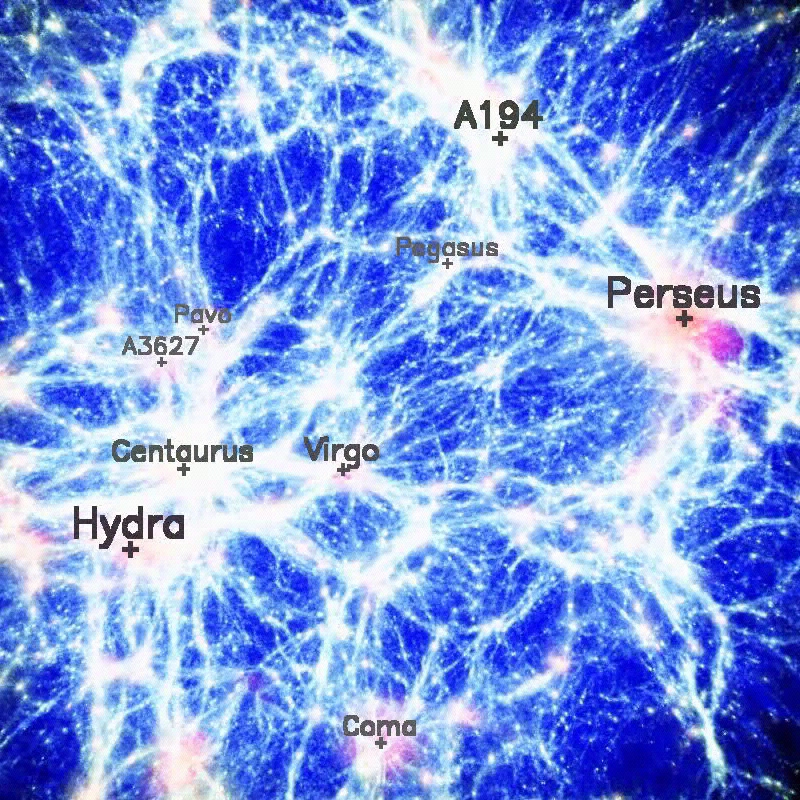 Same simulation as done in the constrained realization
project but including diffuse baryons. Visualized is the gas
temperature. Structures which can be identified directly
with observed galaxy clusters are labeled.
Same simulation as done in the constrained realization
project but including diffuse baryons. Visualized is the gas
temperature. Structures which can be identified directly
with observed galaxy clusters are labeled.
 Local Universe [mpeg-4, 30.3 MB, 800x800]
Local Universe [mpeg-4, 30.3 MB, 800x800]
Credit: Klaus Dolag
Simulation code: Gadget-2
Vizualisation code: Splotch
Movies of individual galaxies
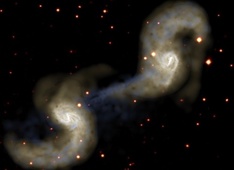 This
movie shows two colliding and merging spiral galaxies. The simulation
follows dark matter, gas, and a stellar component, but only the baryonic
component is visualized. This
movie shows two colliding and merging spiral galaxies. The simulation
follows dark matter, gas, and a stellar component, but only the baryonic
component is visualized.
 Galaxy
collision [divx5, 4.2 MB, 576x576] Galaxy
collision [divx5, 4.2 MB, 576x576]
 Galaxy
collision [mpeg-2, 13.9 MB, 576x576] Galaxy
collision [mpeg-2, 13.9 MB, 576x576]
Credit: Volker Springel
Simulation code: Gadget
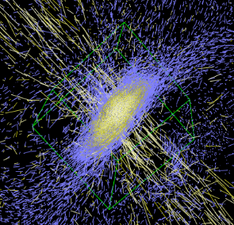
The formation of a "galactic fountain" in a forming disk galaxy. The
simulation includes a model for star formation and galactic winds. In
this particular galaxy, the winds generated by ongoing star formation
are confined by the gravitational potential of the dark matter halo, giving
rise to a "galaxtic fountain".
 Galactic
fountain [mpeg-2, 48.2 MB, 416x416] Galactic
fountain [mpeg-2, 48.2 MB, 416x416]
Credit: Volker Springel
Simulation code: Gadget
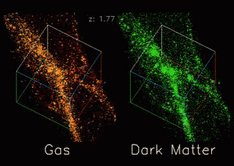 This
animation shows galaxies forming in a "pancake". This
animation shows galaxies forming in a "pancake".
 Forming
galaxies [mpeg-1, 2.1 MB, 320x240] Forming
galaxies [mpeg-1, 2.1 MB, 320x240]
 Zoom
into galaxies [mpeg-1, 1.7 MB, 320x240] Zoom
into galaxies [mpeg-1, 1.7 MB, 320x240]
Credit: Matthias Steinmetz
Simulation code: GrapeSPH
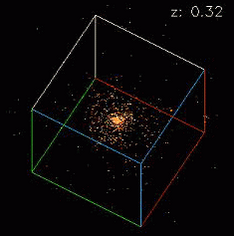
These movies shows the evolution of halos with quiescent and violent
merging histories, respectively.
 Quiescent
history [mpeg-1, 2.3 MB, 240x288] Quiescent
history [mpeg-1, 2.3 MB, 240x288]
 Violent
history [mpeg-1, 2.9 MB, 240x288] Violent
history [mpeg-1, 2.9 MB, 240x288]
Credit: Matthias Steinmetz
Simulation code: GrapeSPH
Technical notes on movie formats
The movies above are encoded in a variety of different formats, ranging
from MPEG-1 to MPEG-4 (divx). Depending on your system, you may have to
install additional software to properly play them, and on some systems,
playback may not be possible at all, unfortunately.
On Linux, you can play all formats using the  Mplayer
application. For divx5 support, you should first install the Mplayer
application. For divx5 support, you should first install the  divx5-codec
(free), and then compile Mplayer. divx5-codec
(free), and then compile Mplayer.
On Windows, you can also install the free  divx5
package, which also contains a player application. The quicktime format
can be played using the divx5
package, which also contains a player application. The quicktime format
can be played using the  quicktime
player from Apple. MPEG-1/2 playback should be possible with software
DVD-player applications. quicktime
player from Apple. MPEG-1/2 playback should be possible with software
DVD-player applications.
On Mac OS, the free version of  divx5
should allow a playback of our movies in the built-in quicktime player. divx5
should allow a playback of our movies in the built-in quicktime player.
Pictures of high-resolution simulations of clusters of galaxies
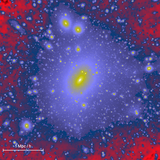 A
very high-resolution simulation of a cluster of galaxies (about 20 million
particles within the virial radius). A
very high-resolution simulation of a cluster of galaxies (about 20 million
particles within the virial radius).
 1024
x 1024, png format 0.47 MB 1024
x 1024, png format 0.47 MB
 512
x 512, png format 400 kB 512
x 512, png format 400 kB
Credit: Volker Springel
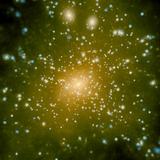 The
dark matter substructure in a rich galaxy cluster. The
dark matter substructure in a rich galaxy cluster.
 1500
x 1500, jpeg format 0.56 MB 1500
x 1500, jpeg format 0.56 MB
 512
x 512, jpeg format 85 kB 512
x 512, jpeg format 85 kB
Cosmic structure viewed in 3D
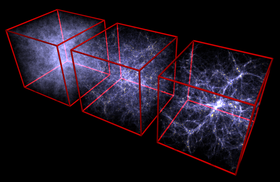 Structure
formation in the gaseous component of the universe, in a simulation box
100 Mpc/h on a side. From left to right: z=6, z=2, and z=0. Formed stellar
material is shown in yellow. Structure
formation in the gaseous component of the universe, in a simulation box
100 Mpc/h on a side. From left to right: z=6, z=2, and z=0. Formed stellar
material is shown in yellow.
 2160
x 1400, png format 2.5 MB 2160
x 1400, png format 2.5 MB
 1083
x 702, png format 1.7 MB 1083
x 702, png format 1.7 MB
 740
x 480, png format 960 kB 740
x 480, png format 960 kB
Credit: Volker Springel
Comments to: Virgo Administrator  virgo@mpa-garching.mpg.de
virgo@mpa-garching.mpg.de

|
 |



![]()




